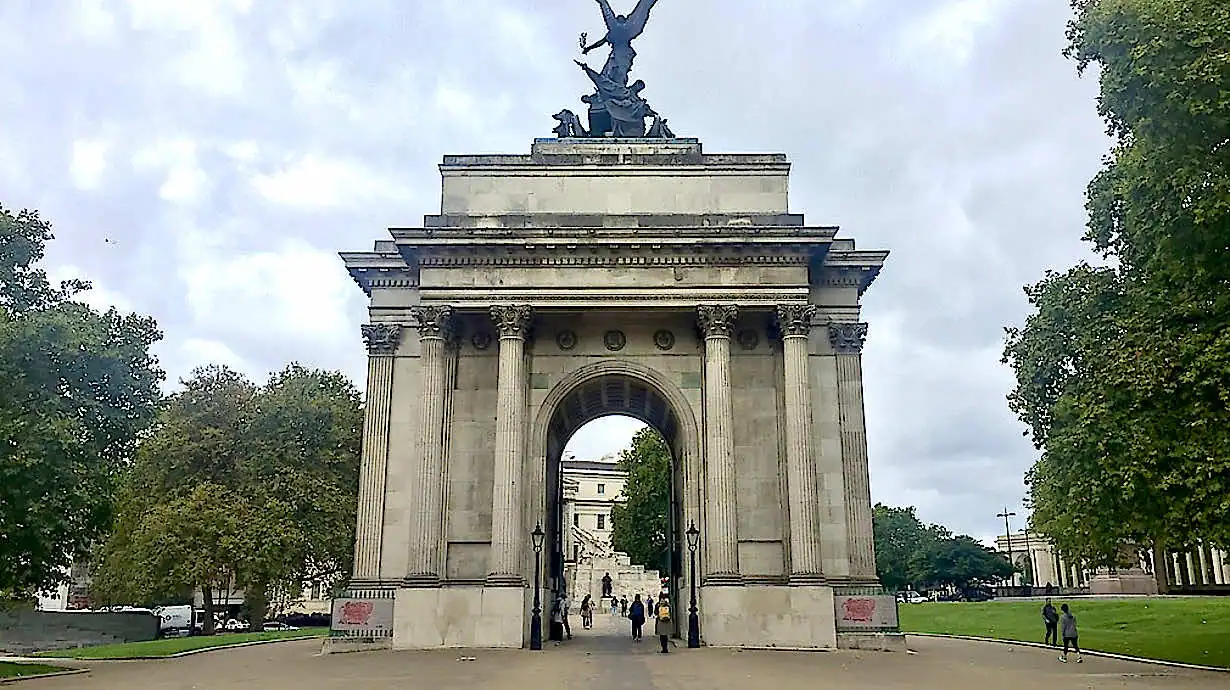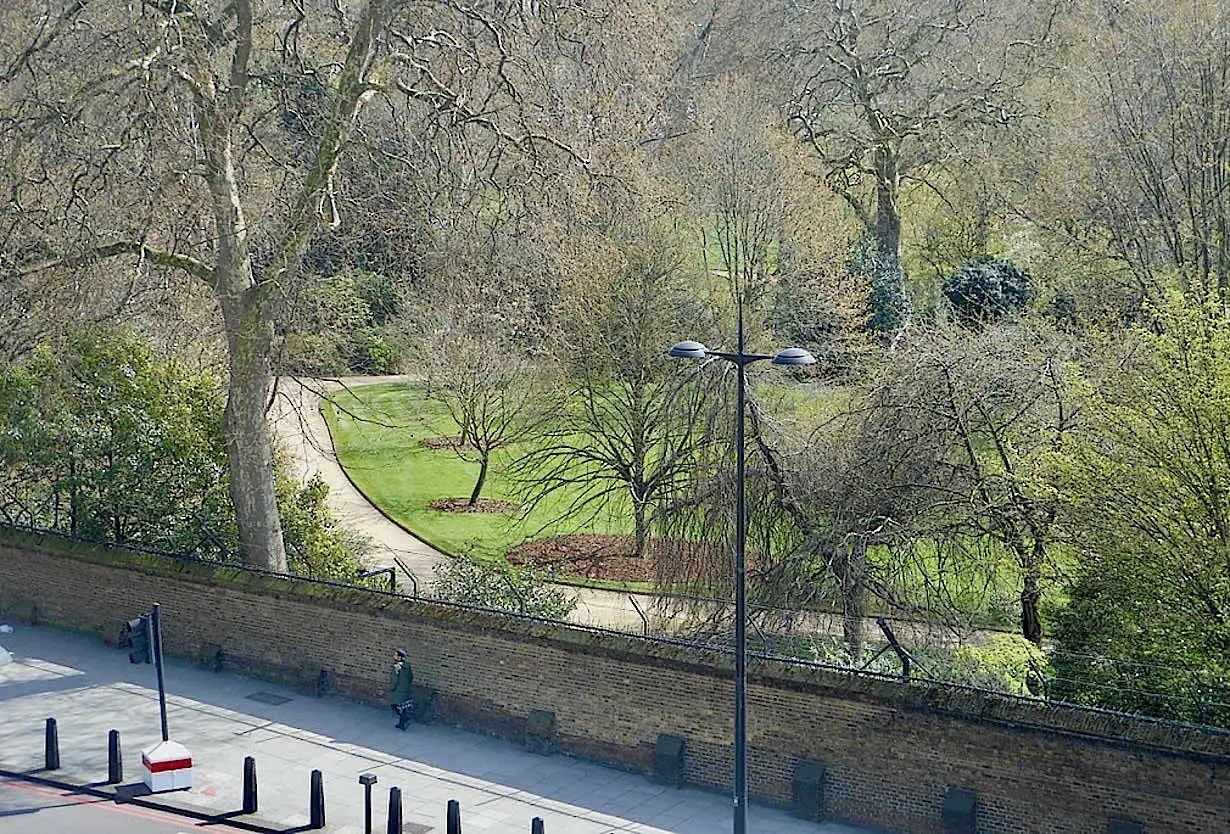It’s hard to picture it now with all the traffic roaring round Hyde Park Corner but two hundred years ago this was on the very edge of London. You’ve got to imagine the grand houses of Piccadilly stretching all the way up to Apsley House and then just fields and trees to Kensington Palace. (That’s why Apsley House was nicknamed No.1 London – because it was the first big house you saw by the Kensington Turnpike tollgate.)
 Photo: londondrum.com
Photo: londondrum.comHistory of the Wellington Arch
After our victory over Napoleon they decided to build a grand processional route from the edge of town to Buckingham Palace. The idea was that the soldiers would all assemble in the park and march through that decorative gateway to the Green Park Arch (as it was then called), then parade down Constitution Hill to Marble Arch. (Marble Arch was later moved to the top end of Oxford Street – but it originally stood outside the palace.)
Duke of Wellington’s equestrian statue
A government committee then suggested that it would be a fine idea if the project also included two new monuments for the big heroes of the war, so Nelson got his column in Trafalgar Square and Wellington was promised a statue on top of the Green Park Arch outside his house.
Unfortunately their attempt to impress him by building the country’s largest-ever equestrian statue backfired somewhat when the huge horse was lifted into position because even the architect admitted it looked ridiculous. It met with so much derision that the government made moves to remove it until Wellington let it be known that he’d consider it a personal insult.
 Photo: londondrum.com
Photo: londondrum.comArch moved to the top of Constitution Hill
And that’s how things stayed until thirty-six years after the Duke’s death when the entire arch was moved a short distance across the top of the hill so they could slice a new road behind it. The horse was then re-located to Aldershot and a smaller one was put up opposite Apsley House, close to where the arch originally stood (actually it was a little further to the west, lining up exactly with the centre of that decorative gateway).
 Photo: londondrum.com
Photo: londondrum.comBut that’s not quite the end of the story, because eighty years later the Victorian horse and carts had turned into modern motors and they had to re-route all of the roads again, marooning the arch on its own little island.
Exhibition inside Wellington Arch
They’ve got a little exhibition inside which is worth a visit. The first room goes over its history and includes a few interesting pictures and paintings of the arch in its original position. You can see some old photos of the huge horse on top as well.
 Photo: londondrum.com
Photo: londondrum.comThe next three rooms contain temporary exhibitions and can be a bit hit and miss, showing everything from old panto posters to photos of the trenches in World War I.
View of Apsley House from the balcony
After climbing a few flights of stairs you’ll step out onto a balcony overlooking Apsley House and the decorative gateway half-hidden behind some trees. (I wish they would chop those trees down!)
 Photo: londondrum.com
Photo: londondrum.comThe balcony on the other side looks across Constitution Hill towards Big Ben and the London Eye. While the wind is grabbing and flapping at your coat check out that boring brick wall on the righthand side that’s topped off by a wire fence, because over the other side of that are the gardens of Buckingham Palace.
 Photo: londondrum.com
Photo: londondrum.comYou can’t see the actual palace itself because it’s totally hidden behind the trees, but you can see a short stretch of gravel path and maybe some tennis courts (it’s difficult to make them out through the foliage). I’m always hoping that I might get lucky and see the King and Queen Consort but they probably avoid that area for security reasons.
I also recommend… If you enjoy this then try Apsley House (you can walk there in less than 1 min) and Marble Arch (walk it in 16 mins or travel from Hyde Park Corner to Marble Arch by underground). You can also visit the Duke of Wellington’s tomb at St. Paul’s Cathedral, and some of his Waterloo memorabilia at the National Army Museum
How to get to Wellington Arch
| Fare zone | Cash | Oyster & Contactless | Travelcard | ||||
|---|---|---|---|---|---|---|---|
| Single fare | Single fare | Daily cap | One day | ||||
| Peak | Off-peak | Peak | Off-peak | Anytime | Off-peak | ||
| Bus (all zones) | n/a | £1.75 | £5.25 | £6 | |||
| Train (zone 1) | £7 | £2.90 | £2.80 | £8.90 | £8.90 | £16.60(zone 1-4) | £16.60(zone 1-6) |
| Train (zone 1-2) | £7 | £3.50 | £2.90 | £8.90 | £8.90 | ||
| Train (zone 1-3) | £7 | £3.80 | £3.10 | £10.50 | £10.50 | ||
| Train (zone 1-4) | £7 | £4.60 | £3.40 | £12.80 | £12.80 | ||
| Train (zone 1-5) | £7 | £5.20 | £3.60 | £15.30 | £15.30 | £23.60(zone 1-6) | |
| Train (zone 1-6) | £7 | £5.80* | £3.80* | £16.30 | £16.30 | ||
| * Journeys between zone 1 and Heathrow are always charged at the peak rate. Prices are correct as of | |||||||
Related articles and events
See what’s on in Knightsbridge

 Twitter
Twitter Facebook
Facebook Bluesky
Bluesky WhatsApp
WhatsApp Email
Email





